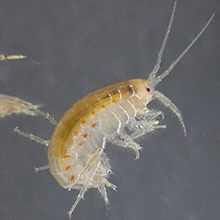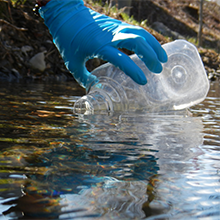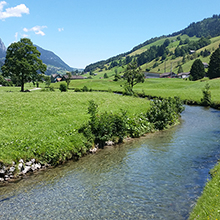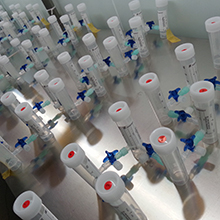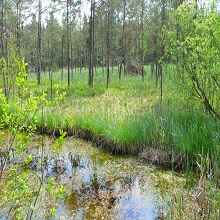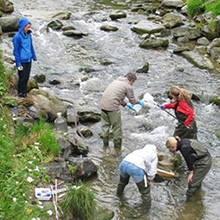Staff
Florian Altermatt
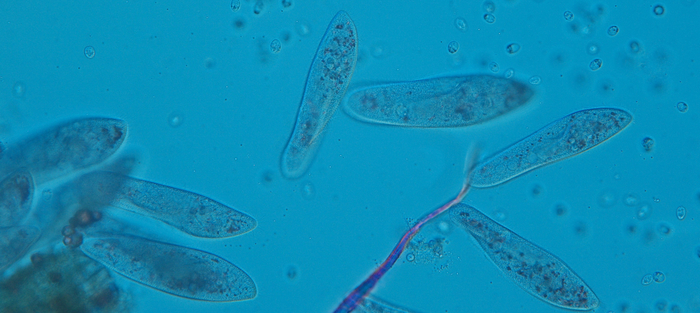

Prof. Dr. Florian Altermatt
About Me
I am Full Professor fo Aquatic Ecology at University of Zurich and Eawag. To learn more about my lab and research, visit the homepage of the Altermatt lab and my webpage at University of Zurich.
Research
I am a community ecologists in a wide sense. I would like to understand how species occur in space and time, how dispersal and landscape structure affect community composition and diversity and how processes such as climate change or species invasions affect dynamics within and between communities.
My and my group's research is centered around the following questions:
> How do spatial dynamics affect biodiversity and ecosystem functioning?
> How are species interactions affected by global changes?
> How to fundamentally assess biodiversity using environmental DNA (eDNA)?
Our research falls into the following categories:
1) Spatial Ecology and Meta-ecosystems
Ecosystems are not isolated, but are commonly connected via flows of non-living materials (e.g., detritus, nutrients) and the movement of living organisms. As posited by the meta-ecosystem framework, these connections between ecosystems mean that the properties of one ecosystem—such as its community composition, biomass structure, or functions—can influence the ecosystem it is connected to. Likewise, such connections mean that ecological change in one ecosystem can spatially cascade to impact the properties of different ecosystems.
My group aims to develop our understanding of meta-ecosystem dynamics through a combination of mathematical models, experiments, and field observations. We develop mathematical models and use protist experiments to make and test predictions on the impacts spatial flows between ecosystems have on biodiversity and ecosystem functions in a changing world. Further, we study naturally replicated forest-headwater stream meta-ecosystems to characterize the spatial and temporal characteristics of spatial flows, how they are changing across seasons and how they shape decomposer communities, with a focus on amphipods.
2) Environmental DNA to assess biodiversity
All organisms shed DNA into their environment. This so-called environmental DNA (DNA) can be collected and extracted. Using molecular advancements, we sequence eDNA to gain biodiversity information – from microbes to mammals – characterizing organismal communities and whole food webs. As a group, we have made fundamental contributions in the development and application of eDNA to assess biodiversity in aquatic ecosystems.
Our work covers a broad range of eDNA research from nationwide invasive species detection to constructing interaction networks, predicting biodiversity across riverine networks and exploring hard to study ecosystems, such as groundwater. We are also interested in exploring fundamental questions of eDNA by modeling the origin, transport and fate of biodiversity signals within large river networks. Alongside our combined research interests, we play a key role in the development and end-user uptake of eDNA techniques. By collaborating at the local, national and international scale, we have contributed to national guidelines, DNA methodological handbooks and run workshops to offer guidance and aid the implementation of eDNA for biomonitoring.
3) Biodiversity of freshwater amphipods
Amphipods are key organisms in freshwater ecosystems and commonly used as indicator taxa for biomonitoring and ecotoxicology. We study the diversity, biogeography and ecology of freshwater amphipods, with a focus on the European Alps/Switzerland. We thereby integrate knowledge on natural history, taxonomy and spatial distribution of surface and groundwater amphipods to understand how their contemporary species and genetic diversity have been shaped by macroecological and anthropogenic drivers.
In the project Amphipod.CH we have established the first complete overview of all 60+ species of amphipods in Switzerland. In long-term replicated stream catchments, we are studying how community structure and turnover is shaped by terrestrial land-use and species interactions, and linking amphipod occurrence to leaf litter decomposition and overall ecosystem functioning. In the project AmphiWell, we study the diversity of groundwater amphipods, combining innovative citizen-science, eDNA approaches and advanced molecular tools to understand the diversity and distribution of groundwater fauna. We thereby have discovered and described many species of Niphargus as new to science. Many of these endemic species are glacial relicts predating late Pleistocene glaciation and part of Switzerland’s natural heritage.
Selected publications: (Google Scholar)
- Peller T & Altermatt F. 2024. Invasive species drive cross-ecosystem effects worldwide. Nature Ecology and Evolution 8: 1087–1097.
- Peller T, Guichard F & Altermatt F. 2023. The significance of partial migration for food-web and ecosystem dynamics. Ecology Letters 26: 3–22.
- Haase P, Bowler DE, Baker NJ, Bonada N, Domisch S, Garcia Marquez JR, Heino J, Hering D, Jähnig SC, Schmidt-Kloiber A, Stubbington R, Altermatt F, ... & Welti EAR. 2023. The recovery of European freshwater biodiversity has come to a halt. Nature 620: 582–588.
- Altermatt F, Carraro L, Antonetti M, Albouy C, Zhang Y, Lyet A, Zhang X & Pellissier L. 2023. Quantifying biodiversity using eDNA from water bodies: general principles and recommendations on sampling design. Environmental DNA 5: 671-682.
- Ho H-C, Brodersen J, Gossner MM, Graham CH, Kaeser S, Chacko MR, Seehausen O, Zimmermann NE, Pellissier L & Altermatt F. 2022. Blue and green food webs respond differently to elevation and land use. Nature Communications 13: 6415.
- Luo M, Wang S, Saavedra S, Ebert D & Altermatt F. 2022. Multispecies coexistence in fragmented landscapes. Proceedings of the National Academy of Sciences 119: e2201503119.
- Carraro L, Mächler E, Wüthrich R & Altermatt F. 2020. Environmental DNA allows upscaling spatial patterns of biodiversity in freshwater ecosystems. Nature Communications 11: 3585.
- Altermatt F, Little CJ, Mächler E, Wang S, Zhang X & Blackman RC. 2020. Uncovering the complete biodiversity structure in spatial networks – the example of riverine systems. Oikos 129: 607–618.
- Gounand I, Little CJ, Harvey E & Altermatt F. 2018. Cross-ecosystem carbon flows connecting ecosystems worldwide. Nature Communications 9:4825.
- Gounand I, Harvey E, Little CJ & Altermatt F. 2018. Meta-ecosystems 2.0: rooting the theory into the field. Trends in Ecology and Evolution 33: 36–46.
- Deiner K, Fronhofer EA, Mächler E, Walser J-C & Altermatt F. 2016. Environmental DNA reveals that rivers are conveyer belts of biodiversity information. Nature Communications 7:12544.
- Fronhofer EA, Klecka J, Melian CJ & Altermatt F. 2015. Condition-dependent movement and dispersal in experimental metacommunities. Ecology Letters 18: 954-963.
- Fronhofer EA & Altermatt F. 2015. Eco-evolutionary feedbacks during experimental range expansions. Nature Communications 6:6844.
- Giometto A, Rinaldo A, Carrara F, and Altermatt F. 2014. Emerging predictable features of replicated biological invasion fronts. Proceedings of the National Academy of Sciences 111: 297-301.
- Altermatt F. 2013. Diversity in riverine metacommunities: a network perspective. Aquatic Ecology 47: 365–377.
- Pearse IS and Altermatt F. 2013. Predicting novel trophic interactions in a non-native world. Ecology Letters 16:1088-1094.
- Carrara F*, Altermatt F*, Rodriguez-Iturbe I and A Rinaldo. 2012. Dendritic connectivity controls biodiversity patterns in experimental metacommunities. Proceedings of the National Academy of Sciences 109: 5761-5766. * these two authors contributed equally to the work.
- Altermatt F & Ebert D. 2008. Genetic diversity of Daphnia magna populations enhances resistance to parasites. Ecology Letters 11: 918–928.
[[ element.title ]]
Projects
[[ element.title ]]
Curriculum Vitae
| [[ entry.date || 'empty' ]] |
[[ element.title ]]
[[ element.title ]]
[[ element.title ]]
Address
| E-Mail: | florian.altermatt@cluttereawag.ch |
| Phone: | +41 58 765 5592 |
| Fax: | +41 58 765 5802 |
| Address: | Eawag
Überlandstrasse 133 8600 Dübendorf |
| Office: | BU G14 |

